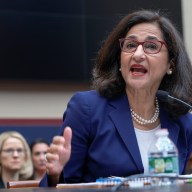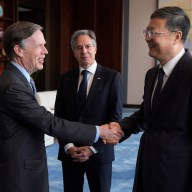TV star Cynthia Nixon, best known for her role as Miranda on “Sex and the City,” created controversy this week when she claimed in a New York Times interview that she chose to be gay, and believes there’s no problem with calling sexuality a choice:
“For me, it is a choice. I understand that for many people it’s not, but for me it’s a choice, and you don’t get to define my gayness for me.”
She states that even if it were up to people to choose, it shouldn’t determine whether or not their lifestyles are more or less legitimate. “It seems we’re just ceding this point to bigots who are demanding it, and I don’t think that they should define the terms of the debate.”
However, an interview that ran Wednesday on “The Daily Beast” shows Nixon implying she may not even be gay – exactly. She used to be in a long-term relationship with high school sweetheart, Danny Mozes, with whom she has two teenage children. But though she’s engaged to longtime girlfriend Christine Marinoni, with whom she’s raising an 11-month-old son, she claims she hasn’t changed at all.
When asked if that meant she’d always been a lesbian, she hedged: “I think for gay people who feel 100 percent gay, it doesn’t make any sense.And for straight people who feel 100 percent straight, it doesn’t make any sense.”
So if both relationships make sense to her, why doesn’t Nixon just call herself bisexual?
Because, she went on to explain, “Nobody likes the bisexuals.Everybody likes to dump on the bisexuals. … We get no respect.”
Not that she would cede her identity to the bigots, right?
The difference between the terms in question can best be explained by what’s known as the Kinsey scale, published by acclaimed sex researcher Alfred Kinsey in 1948. The scale rates sexuality based on a spectrum from 0 — which is complete heterosexuality — to 6, which reflects strict homosexuality. Bisexual individuals fall anywhere in the middle of the scale, from 1 to 5. The questions that are used to determine where a person lands factor in past, current and future sexual desires. Someone who used to be entirely straight who is now in a gay relationship they expect to stay committed to may not earn a 6, depending on other factors. In this case, they would be objectively classified as bisexual.
So Nixon may or may not feel equally attracted to men in the present, or see herself open to a relationship with a man in the future. But at a point in her past, she was able to choose between men and women and be equally sexually satisfied. Does that mean that she was choosing to be able to choose?
It seems like an entirely separate conversation than one about whether a Kinsey 6 can choose a heterosexual relationship. The discussion might be more relevant if it were about bisexuality being no less credible than any other form of homosexuality — or, of course, gay being no less legitimate a lifestyle whether there’s an opt-out clause or not.
Maybe Nixon never intended to put herself out there as a mouthpiece for all gay or lesbian individuals, but in clarifying her own alignment and desires, it may help people to better understand where she’s coming from with her personal, albeit very public, stance on the matter of elective sexuality. Rather than shut up about a touchy subject, it might be best if she continues to speak out —as a proud bisexual.
The debate as to whether sexuality is a choice and the ramifications of drawing a hard line — socially, politically, legally — is yet another entirely separate topic. But it’s one that thankfully, because of Nixon, people are continuing to avidly explore.
Nixon currently stars onstage in “Wit,” which opens Thursday night, Jan. 26, on Broadway.
Related:

















